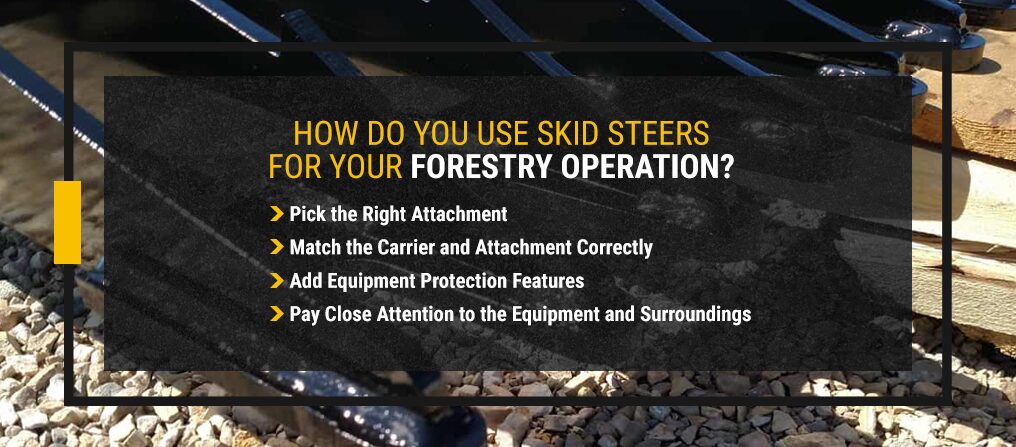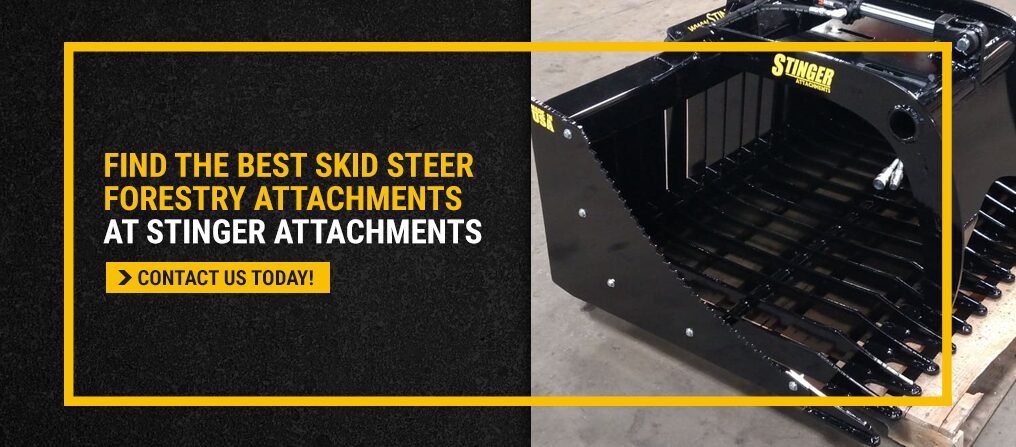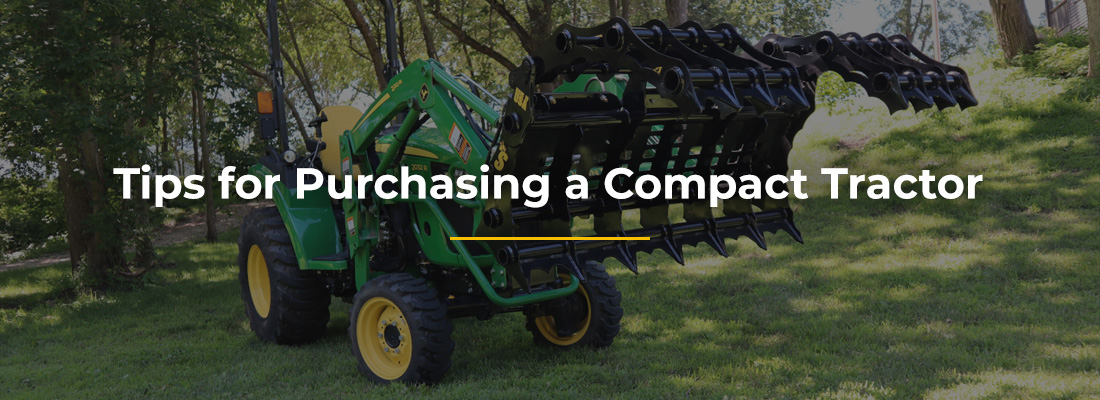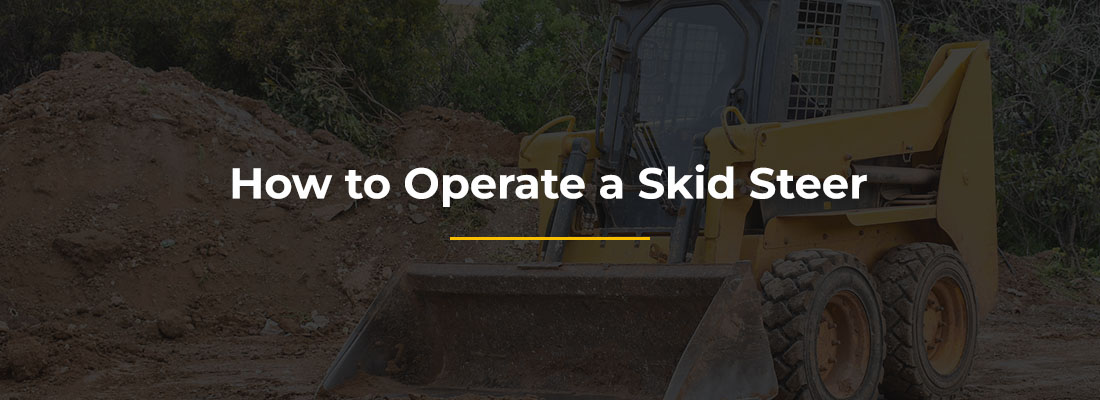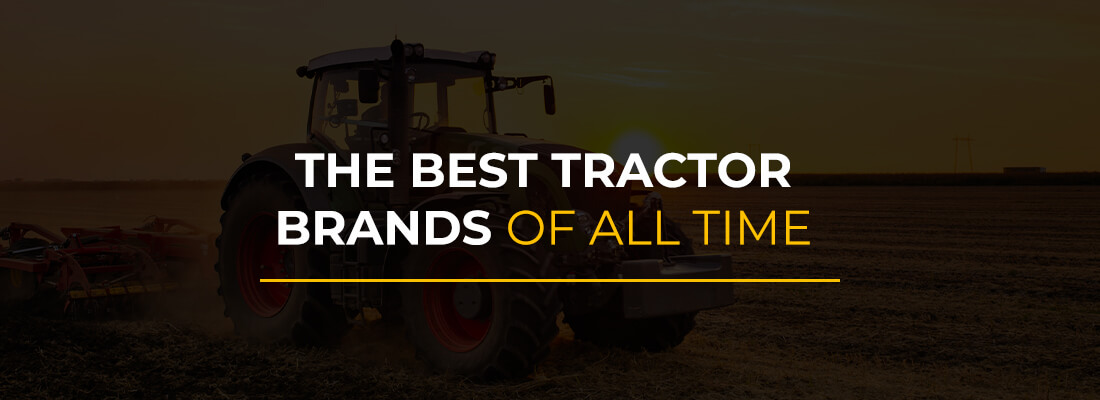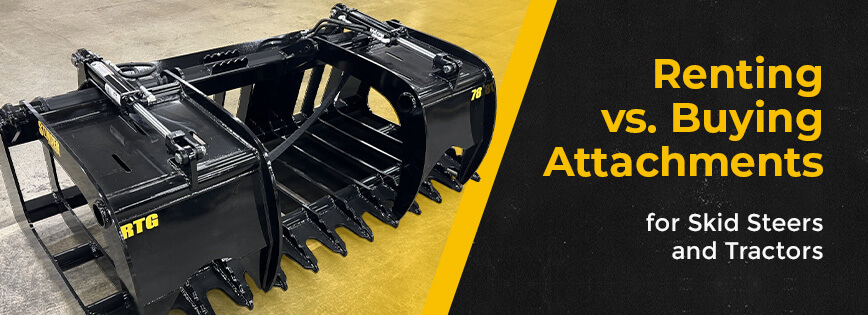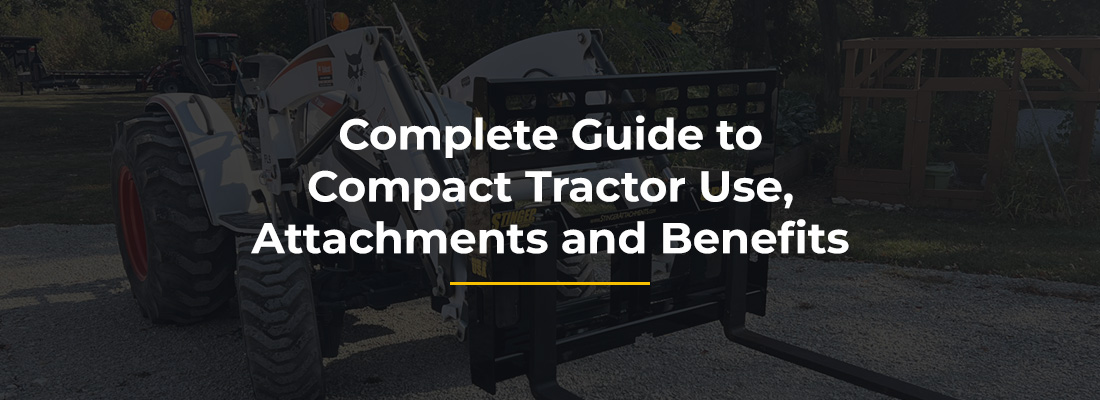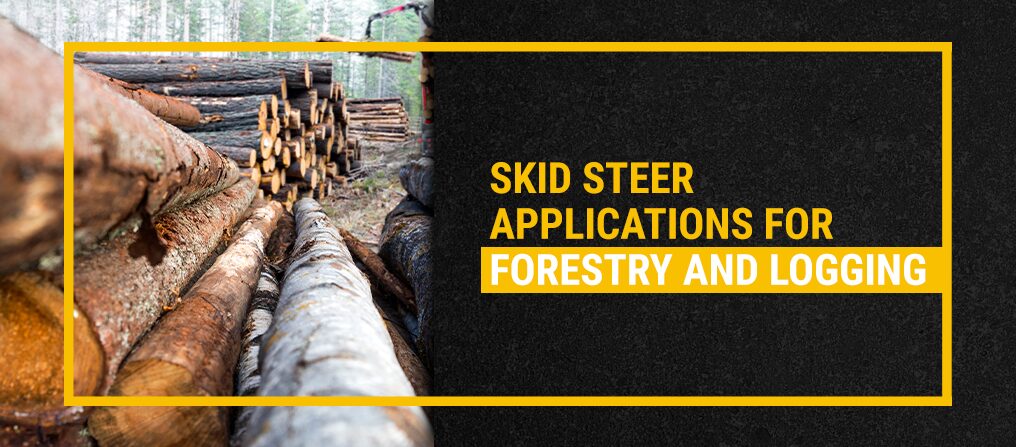
Skid Steer Applications for Forestry and Logging
Skid steers are useful machines for many forestry and logging applications. To make sure your skid steer can handle your project, it must have the right specifications and may need to be equipped with an appropriate attachment. In this guide, we’ll provide tips on how to configure the best setup for skid steer logging applications so you can maximize your machine’s performance and ensure your safety.
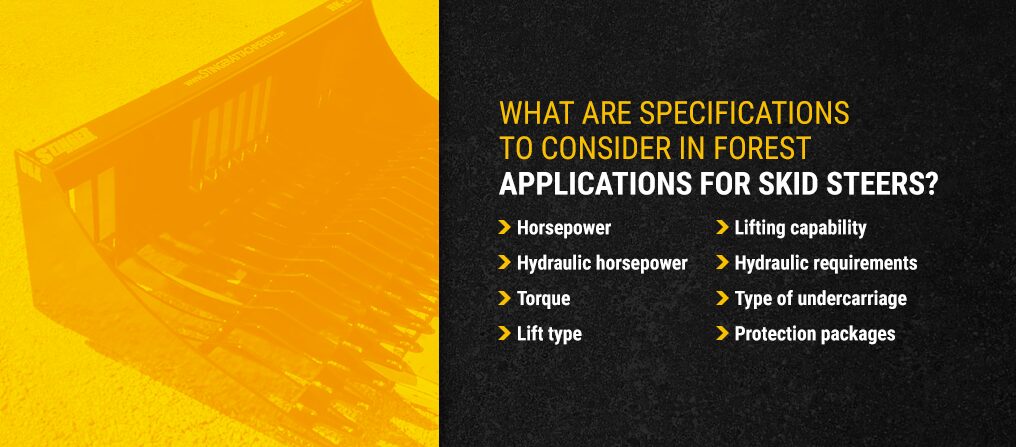
What Are Specifications to Consider in Forest Applications for Skid Steers?
When you use a skid steer for logging and forestry work, your capabilities will vary depending on the specifications of your skid steer and the attachments you choose. Forestry and logging put certain demands on equipment, so the skid steer you use should be optimized for your application. Consider the following factors:
- Horsepower: Although standard-flow attachments can be used for machines without high-flow circuits, we recommend you outfit a high-flow machine with attachments that match. These high-flow machines should have engines with at least 70 horsepower.
- Hydraulic horsepower: You should also consider hydraulic horsepower, which is what does the heavy lifting. A skid steer may have less flow than another but operate at a greater pressure, which ultimately determines the hydraulic horsepower. The majority of production machines with 70- to 100-horsepower engines and high-flow circuits have sufficient hydraulic horsepower for mulching.
- Torque: Torque is a crucial element to help you get the job done on your skid steer. It doesn’t matter how much horsepower you have if you don’t have good torque, so the machine you pick should have high torque.
- Lift type: Skid steers are equipped with one of two lift types: vertical or radial. If you’re going to be working primarily at or above eye level, opt for a vertical lift. If your work will be mainly below eye level, a radial lift will probably be more appropriate.
- Lifting capability: Make sure you know how high your skid steer can lift, and whether it can lift high enough for the attachment you want to use.
- Hydraulic requirements: To attain optimal performance, you must carefully match your skid steer’s hydraulic requirements with your desired mulching attachment. This is a delicate balance of torque and hydraulic horsepower, and it is the most critical consideration when matching a mulching attachment to a skid steer.
- Type of undercarriage: Skid steers have either tracks or wheels, and both undercarriages have advantages and drawbacks. When picking a style, carefully consider the conditions of the ground. In mulching, machines with tracks have become the more popular option because they provide more traction and stability on inclines and slopes.
- Protection packages: Skid steer manufacturers often offer forestry protection packages, which can significantly increase safety.
What Are Considerations for Mulching Attachments for Skid Steers Used in Forestry and Logging?
To ensure optimal performance, it’s also extremely important to match your desired mulching attachment to the capabilities of your machine. To do so, keep the following considerations in mind:
- Cutting width: Skid steer logging attachments typically offer a cutting width of 5 feet, although this can vary considerably. Make sure your attachment has the cutting width you need.
- Weight: Make sure your machine is able to handle the attachment’s weight, especially at the height you anticipate operating. Certain brands offer ways to assist with the balance, such as counterweights.
- Safety features: Attachments often come with a number of safety features and guards to protect the operator and anyone else who is nearby. Examples of safety features include chain guards and hydraulic doors, which help to deflect debris down to the ground where it won’t cause any harm. Polycarbonate doors shield the operator from high-speed airborne debris.
- Performance features: When choosing an attachment, you should consider how you intend to use it as well as the terrain and material types you’ll be encountering. For instance, if you see yourself working on rocky soil, choose an attachment that can withstand these abrasive materials and avoid ones that are designed to cut sharply. For the best results, consider the benefits and drawbacks of each attachment and match them to your use.
A skid steer can provide versatility that is unrivaled by most larger, bulkier machines. Matching your mulching attachment to your skid steer — and then to the conditions you’ll be working in — can extend this flexibility even further.
How Do You Use Skid Steers for Your Forestry Operation?
A large part of using skid steers in forestry and logging relies on utilizing attachments. Brush cutters, heavy-duty mowers, mulching heads and other attachments that are hydraulically powered do a great job at converting a skid steer into a land-clearing machine. However, if your attachment isn’t chosen properly, it can hinder you and your logging equipment.
When you pair a skid steer and an attachment for forestry, you must make sure the two are compatible and as safe as possible for you and your machine’s critical components. In this section, we’ll share a few tips on how to use your skid steer for forestry and logging:
1. Pick the Right Attachment
Consider the specific applications where you’ll be working to help you figure out which attachments will work the best. For instance, if you’ll primarily be clearing brush, consider getting a flail cutter or rotary cutter. If you’ll be removing stumps and bigger trees, you should instead consider a stump grinder and forestry cutter attachment.
2. Match the Carrier and Attachment Correctly
Once you’ve figured out your application and the attachments you need, ask a dealer in your area about correctly matching the attachment and carrier. Important specifications include your skid steer’s size, the operating capacity it’s rated at, its horsepower and the hydraulic flow available to power the attachment. If you use an attachment with a machine that’s under-powered, lower productivity may result.
You’ll also want to consider the weight of the attachment and the weight of the materials you’ll be lifting. Make sure your skid steer can effectively lift both of these.
3. Add Equipment Protection Features
As land clearing can be hard on your equipment without proper precautions, you should add some features that can reduce the risk of your components wearing out prematurely. If you want to add an attachment to a skid steer you already own that wasn’t designed specifically for forestry, you will probably have to add on several protection options, depending on your application. For instance, you should consider adding an auxiliary oil cooler, which will prevent your hydraulic oil from overheating or doing damage to your motor and pump.
Another good idea is adding pre-cleaners and aspirators to protect air intakes, which can preserve the performance of your engine. You can protect your tires using tire liners or, if your application is really heavy duty, you can add over-the-wheel steel or rubber tracks. The manufacturer may also offer a forestry kit, which can provide extra protection for machine doors, lights, windows and other parts.
Of course, the biggest priority is protecting the operator. For this reason, your machine should be equipped with a severe-duty or impact-resistant door, which is usually not made of glass. Such a door may consist of a Lexan material and may be coated with a scratch-resistant polycarbonate. Other safety options for the operator could include a protection plate to guard against falling debris, add-on rear and side screens, hydraulic and cylinder coupler guards as well as an add-on heavy-duty back bumper.
4. Pay Close Attention to the Equipment and Surroundings
Keeping your skid steer and attachments in a safe and productive condition requires your full attention. You must know exactly what the attachment is meant for and avoid using it for anything other than its specified purpose. For example, if you must push dirt but your attachment wasn’t designed to push dirt, do not use it.
When operating your skid steer, check the visibility around your machine as often as you can. Clearing land involves going over lots of uneven terrain, which can catch you by surprise if you’re not paying close attention. Here are some other things to watch out for frequently:
- Accumulation of airborne debris: Activities like shredding brush may cause airborne debris to build up in hot places in the engine compartment and on screened areas on your power unit. This can cause the equipment to overheat and pose a fire hazard, so it is extremely important to open up all shields and screens regularly and clean out the entire machine with a pressure washer or compressed air.
- Dirty windows: Airborne debris that causes the above issues can also lead to dirty side windows and polycarbonate windshields. If you do not keep these windows clean, the resulting poor visibility can affect your efficiency and safety. However, you don’t want to clean your windows too often because this can scratch the surface of the windshield. Instead, you should first rinse off the majority of the debris using water, then wipe the rest away.
- Debris in critical areas: Pay special attention when cleaning out debris in critical places. Any time you remove knives, carbide tips or a shear bar to service them, make sure to clean out their mating surfaces using a scraper, pressure washer or compressed air. If you leave any debris between surfaces, it may prevent bolts from holding these important parts in place.
- Accumulation on attachments: On mulching attachments, debris and tree sap can accumulate on the knives and rotor surfaces, which can cause an imbalance of the rotor that might reduce bearing life.
If you’re planning to complete logging with a skid steer, the following attachments can make the job drastically easier:
1. Tree Pullers
A tree puller attachment features dynamic digging and clamping action, allowing you to pull trees measuring up to 10 inches in diameter. The tree puller’s firm grip and structural steel design also allow you to loosen and take out a variety of objects, including:
- Rocks
- Fence posts
- Shrubs
- Stumps
- Large weeds
- Debris
2. Stump Buckets
Stump buckets feature a cutting edge shaped like teeth, which makes it easy to loosen and dig stumps out. The bucket also has a deep bottom, allowing you to have more capacity and leverage when you trench. In addition to removing stumps, you can also use a stump bucket to take out large rocks.
3. Stump Grapples
A stump grapple is a stump bucket with an attached grapple, which maximizes your power to pull out stumps. The sides help to rip through roots to loosen the stumps and facilitate removal. The bucket also curves up at the front, allowing for easier trenching. With a grapple added to the bucket, its abilities are doubled. Like a normal stump bucket, it can trench and pull out stumps, and the grapple allows it to also haul material and get a tighter grip on stumps.
4. Root Grapples
A root grapple features two independent, heavy-duty grapples that help with pulling out small stumps and tough roots. Its open bottom framing lets the grapple deal with stumps, large trees, rocks, building materials and much more as small debris falls through. This attachment is quite versatile, as its front tines enable it to pull up roots, rocks and small stumps during the process of land clearing. In demolition projects, the tines help force the bucket into debris piles and serve as a wedge that pushes further and grabs a larger amount of materials in a scoop.
5. Grapple Buckets
These buckets allow you to grab massive amounts of materials with their extreme-duty steel grapples. They’re perfect for lots of tasks, including construction, agriculture and demolition, although they’re great for logging and forestry as well. The grapple bucket is made to collect debris and material, secure that material in the bucket and haul it away. At Stinger Attachments, the dual claw grapple buckets we offer feature an opening height of 4 feet, which can make your job more efficient.
6. Pallet Forks
If you equip your skid steer with a pallet fork, you’ll be able to lift trees and logs and move them vertically or horizontally. You can also use it to clear treetops and bulkier brush.
Find the Best Skid Steer Forestry Attachments at Stinger Attachments
At Stinger Attachments, we are committed to making your forestry and logging jobs easier by providing the high-quality attachments you need. We forge strong working relationships with the hardworking people in logging and forestry, and they value our service for the following benefits:
- Generous warranty: At Stinger Attachments, we are confident in the quality of our products, and with our one-year warranty, you can be too.
- Quality, one-on-one customer support: If you have any questions, you can speak directly with skid steer experts.
- Great shipping rates: We offer bundled shipping discounts and flat-rate shipping based on where you live.
- Direct-to-buyer sales: We don’t use a middleman, meaning we can offer you more affordable prices for our high-quality products.
If you have any questions about the skid steer forestry attachments we offer or their uses and compatibility, reach out to us at 507-273-7497 or contact us using our form today.

